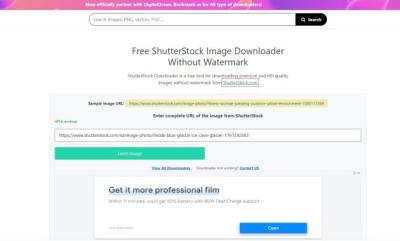If you’ve ever needed high-quality images to enhance your professional projects, Shutterstock is a goldmine of options. Whether you’re designing a website, creating marketing materials, or putting together a presentation, the right visuals can make all the difference. But navigating Shutterstock‘s vast library and understanding how to use images legally can sometimes feel overwhelming. Don’t worry—we’re here to guide you through the essentials. By understanding how
Understanding Shutterstock Licensing Options and Restrictions

When it comes to using Shutterstock photos professionally, the key is understanding their licensing options — mainly Standard and Extended licenses — and what each permits you to do. Think of licenses as the rules of the road; knowing them helps you avoid legal pitfalls and ensures your project runs smoothly.
Standard License
The Standard license is the most common and suits most everyday projects. It allows you to use images in a wide range of media, such as websites, social media, presentations, marketing materials, and print up to 10,000 copies. Here are some important points:
- Usage Limitations: No unlimited print runs or high-volume distribution.
- Restrictions: Cannot use images for merchandise like T-shirts, mugs, or products for resale.
- Duration: Usually, there are no time limits—you’re good to use the image as long as your project lasts.
Extended License
If your project requires broader usage, such as creating products for resale or unlimited print runs, you’ll need an Extended license. It offers more flexibility but comes at a higher cost. Key features include:
- Unlimited Copies: Use images in products for resale like posters, apparel, or packaging.
- Commercial Use: Suitable for items that generate revenue or are distributed widely.
- Restrictions: Still cannot be used in a way that suggests endorsement or directly associates the image with a specific product or service.
Restrictions to Keep in Mind
Even with the right license, there are some restrictions. You can’t:
- Re-sell or distribute the images as standalone files. For example, don’t give away or sell copies of the raw images.
- Use images in a defamatory or unlawful manner.
- Alter images in a way that could harm the subject’s reputation.
Final Tips
Always review the license agreement carefully before downloading and using an image. If you’re unsure whether your intended use falls under a license, it’s better to consult Shutterstock‘s licensing FAQ or contact their support. Proper licensing not only keeps you on the right side of copyright law but also respects the artists and photographers who create these stunning visuals. Happy sourcing!
Steps to Find High-Quality Photos on Shutterstock

Looking for those perfect images to elevate your project? Shutterstock is a treasure trove of high-quality photos, but knowing how to navigate it efficiently can make all the difference. Here’s a simple, step-by-step guide to help you find the best photos for your needs:
- Start with Clear Search Terms: Think about what exactly you’re after. Use specific keywords that describe your desired image. For example, instead of searching for “business,” try “professional team meeting in modern office.”
- Use Filters to Narrow Down Results: Shutterstock offers a range of filters to refine your search. You can filter by:
- Image orientation (horizontal, vertical, square)
- Color scheme to match your branding
- Image type (photo, illustration, vector)
- People included (with or without)
- Price range and licensing options
- Preview Images in Full Size: Always take a moment to view images in full resolution. This helps you assess the quality, clarity, and details needed for professional use.
- Check Licensing and Usage Rights: Make sure the image’s license allows for your intended use, whether it’s commercial, editorial, or personal. Shutterstock clearly states this information, so review it carefully.
- Create Collections for Future Use: If you find multiple images that could work, save them into collections or folders. This keeps your options organized and makes comparing easier later.
By following these steps, you can save time and ensure you’re selecting only the best, high-quality images that align with your project goals. Remember, patience and clear criteria are key to finding images that truly enhance your professional work.
Tips for Selecting the Right Images for Your Brand and Audience
Choosing the perfect Shutterstock photos isn’t just about picking something that looks good. It’s about finding images that resonate with your brand identity and connect with your audience. Here are some practical tips to guide your selection process:
- Stay Consistent with Your Brand Aesthetic: Think about your brand’s colors, style, and tone. Select images that complement your existing branding. For example, if your brand uses a minimalist palette, opt for clean, uncluttered photos.
- Consider Your Audience’s Preferences: Put yourself in your audience’s shoes. What kind of images will appeal to them? If you’re targeting professionals, images of teamwork, innovation, or success might work best. For a younger crowd, more vibrant or casual images could be more effective.
- Focus on Authenticity: People connect with genuine, relatable images. Avoid overly staged or cheesy stock photos. Look for photos that depict real emotions, diverse groups, and natural settings.
- Match the Image to Your Message: Every image should support the story or message you want to communicate. For example, if you’re promoting wellness, choose images that evoke calm, health, and vitality.
- Think About Composition and Clarity: Select images with good composition, clear focal points, and high resolution. Avoid photos that are blurry, cluttered, or poorly lit, as they can undermine your professionalism.
Remember, the right images can boost engagement, convey your message more effectively, and reinforce your brand identity. Take your time, consider your audience, and choose images that tell your story best. When done thoughtfully, your visuals will not only look great but also create meaningful connections with your viewers.
Best Practices for Incorporating Shutterstock Photos into Your Design and Marketing Materials
Using Shutterstock photos can really elevate your projects, but to make the most of them, it’s important to follow some best practices. After all, a well-integrated image can captivate your audience, while a poorly placed one might distract or even confuse them. Here are some tips to help you incorporate Shutterstock images smoothly and professionally.
1. Choose the Right Image for Your Message
Start by selecting images that align with your brand voice and the message you want to convey. Take your time browsing Shutterstock’s vast library—use relevant keywords, filters, and categories to find the perfect fit. Remember, an image should complement your content, not overpower it.
2. Maintain Consistency in Style and Tone
If your brand has a specific style—like minimalistic, vibrant, or vintage—stick to images that match that aesthetic. Consistency helps your audience recognize your brand instantly and creates a cohesive look across all materials.
3. Optimize Image Quality and Size
High-resolution images look professional, but large files can slow down your website or email load times. Use image editing tools to resize and compress images without losing quality. This ensures your site remains fast and visually appealing.
4. Use Images to Enhance, Not Distract
Place images strategically so they support your text—think about alignment, whitespace, and focal points. Avoid cluttering your design; sometimes, a simple, clean image works better than a busy one. Remember, the goal is to guide your viewer’s eye, not overwhelm them.
5. Incorporate Calls to Action with Your Images
If your goal is to drive engagement—like getting users to sign up or buy—you can overlay text or buttons on your Shutterstock photos. Just make sure they’re easy to read and don’t obscure important parts of the image.
By following these best practices, you’ll ensure that your Shutterstock images boost your branding and effectively communicate your message. When used thoughtfully, they become powerful tools in your creative arsenal.
Ensuring Proper Attribution and Compliance with Shutterstock Terms
It’s crucial to respect Shutterstock’s licensing terms when using their photos. Not only does this keep you legally safe, but it also shows respect for the photographers and artists who create these images. Let’s go over some key points to keep in mind.
Understanding Shutterstock Licensing Options
- Standard License: Suitable for most marketing, advertising, websites, and social media. It generally covers up to 500,000 copies or views.
- Enhanced License: Necessary for products for resale, merchandise, or large-scale print runs. It offers broader rights and fewer restrictions.
Proper Attribution
Unlike some free image sites, Shutterstock typically does not require attribution when you purchase a photo license. However, if you’re using images from Shutterstock’s contributor community that are marked as free or under specific attribution requirements, be sure to give proper credit as specified.
Using Images Correctly
- Always adhere to the license type you’ve purchased. Using a standard license image for a product you plan to resell without upgrading to an enhanced license can lead to legal issues.
- Refrain from redistributing or sharing images outside your licensed project. Each use must be properly licensed.
- Do not modify images in ways that could violate moral rights or misrepresent the original content.
Best Practices for Compliance
- Keep records of your license purchases and any correspondence with Shutterstock.
2. Review the licensing agreement periodically, especially if your project scope changes.3. When in doubt, consult Shutterstock’s licensing FAQ or contact their support team for clarity.4. Respect model and property releases—if the image features identifiable people or private property, ensure releases are obtained and available.
By following these guidelines, you ensure your use of Shutterstock photos remains legal, ethical, and in line with their terms. This not only protects you from potential legal trouble but also supports the creative community that makes these images available for all of us to use responsibly.
Tools and Resources for Managing Shutterstock Images for Professional Use
When you’re working with a large library of Shutterstock images, staying organized is key to maintaining efficiency and ensuring you always find the right visual at the right time. Luckily, there are several tools and resources that can help you manage your images effectively, no matter the size of your collection.
Image Management Software – Applications like Adobe Bridge, Lightroom, or even dedicated Digital Asset Management (DAM) systems can streamline how you organize, tag, and retrieve your Shutterstock photos. These tools allow you to add metadata, keywords, and ratings to images, making searches quick and straightforward.
Shutterstock Contributor Tools – If you’re a contributor or frequently upload images, Shutterstock’s own contributor dashboard offers features like batch uploads, collections, and licensing management. These tools help you keep track of your images’ status and usage rights, reducing confusion and potential licensing issues.
Cloud Storage & Backup Solutions – Use cloud services like Dropbox, Google Drive, or OneDrive to back up your Shutterstock images. Creating organized folders (e.g., by project, client, or topic) ensures you can access your visuals from anywhere and avoid losing valuable assets.
Keywording and Tagging Resources – Effective keywording is vital for searchability. Use keywording tools such as Adobe Lightroom’s keyword suggestions or dedicated apps like PhotoKey. Developing a consistent tagging system helps you quickly locate images based on themes, colors, or subjects.
Workflow Automation – Automate parts of your image management with tools like Zapier or IFTTT. For example, you could set up a workflow that automatically saves new Shutterstock downloads into a specific cloud folder or tags images with predefined keywords.
By combining these tools and resources, you’ll spend less time hunting for the perfect image and more time focusing on your creative or business goals. Remember, the key is consistency—develop a system that works for you and stick to it!
Conclusion and Final Tips for Leveraging Shutterstock Photos in Your Business
Using Shutterstock photos effectively can elevate your brand, enhance your marketing materials, and save you both time and money. To make the most out of these high-quality visuals, keep a few final tips in mind:
- Always respect licensing agreements—whether you’re using images for social media, websites, or print, make sure you understand what’s permitted under your license to avoid legal issues.
- Optimize images for your platform—resize, compress, and format images appropriately to ensure fast loading times and visual clarity across all devices.
- Maintain consistency—use a cohesive style or color palette by selecting images that match your brand’s identity. This creates a professional and unified look.
- Keep your library organized—regularly review and update your image collection, deleting outdated or unused images, and adding new ones to keep your resources fresh.
- Leverage editing tools—don’t hesitate to tweak Shutterstock images with editing software to better fit your project’s specific needs. Simple adjustments can make a big difference.
Remember, the goal is to integrate Shutterstock photos seamlessly into your workflow, enhancing your content without complicating it. By planning your image use strategically and managing your assets wisely, you’ll be able to produce professional-quality work that resonates with your audience.
Finally, stay updated with Shutterstock’s latest offerings and tools. They often introduce new features that can help streamline your process even further. With a combination of smart management, creative editing, and strategic usage, Shutterstock photos can become a powerful asset in your business toolkit.

